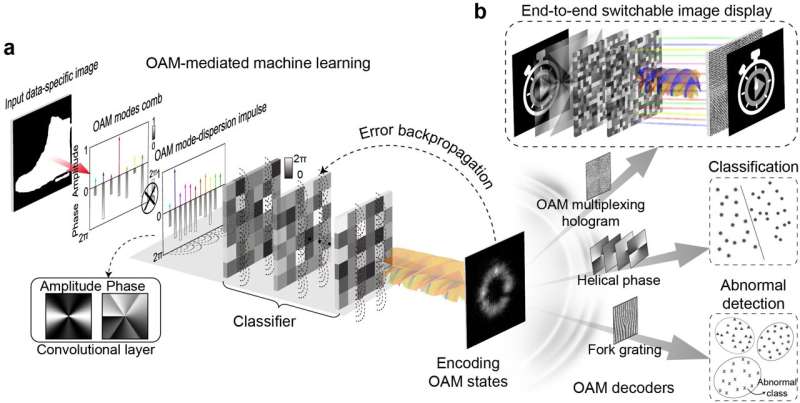

Orbital angular momentum-mediated machine learning for high-accuracy mode-featur...
source link: https://techxplore.com/news/2024-02-orbital-angular-momentum-machine-high.html
Go to the source link to view the article. You can view the picture content, updated content and better typesetting reading experience. If the link is broken, please click the button below to view the snapshot at that time.
February 20, 2024
Orbital angular momentum-mediated machine learning for high-accuracy mode-feature encoding
by Light Publishing Center, Changchun Institute of Optics, Fine Mechanics And Physics, CAS

As a derivative product of artificial neural networks, ChatGPT became extremely popular in 2023, breaking the shortest time record for technology product users to exceed 100 million. It is a large-scale language model based on machine learning (deep learning), in which learning of language rules from massive input texts plays an important role.
Various tasks like translating text, image recognition and natural language understanding can be completed by using ChatGPT through pre-training. Compared with electronics, photons have huge advantages in terms of power efficiency, parallelism (computation capacity) and minimal latency; thus optical neural networks (ONNs) have recently been widely used to achieve more efficient machine learning.
Information in ONNs is carried by different physical dimensions of light such as space, wavelength, amplitude and phase. The orbital angular momentum (OAM), as a unique dimension of light, has already been widely used in optical information processing systems ranging from optical communication, digital spiral imaging to quantum communication for enhancing the information capacity owing to the infinite orthogonality of OAM states. However, it has never been adopted in ONNs for representing information since the lack of the capability to extract the information features in the OAM domain.
In a new paper published in Light: Science & Applications, a team of scientists, led by Professor Min Gu and Prof. Xinyuan Fang from the Institute of Photonic Chip at University of Shanghai for Science and Technology, has developed a new ONNs architecture using OAM-mediated machine learning protocol, in which photonic OAM serves as signals of the nodes of the neural network.
The data features of images are learned in the OAM domain, leading to high-precision intelligent encoding of images into specific one or a few OAM states. The intelligent OAM encoding of images can cooperate with different OAM detecting/demultiplexing devices to complete various OAM information processing tasks, such as image classification, secure free-space image transmission with high-throughput and low latency, and optical anomaly detection.
The realization of learning data features of images in OAM domain is based on a diffraction-based convolutional neural network (CNN) that is composed of two main parts. The first part is the convolution part, which utilizes convolution between the OAM mode spectrum of an image with a trainable OAM mode-dispersion impulse to densify the input OAM mode combs and extract the mode-features.
The second part is a classification block consisting of cascaded finite-aperture trainable diffraction layers, which can achieve mode-features compression. That is, it controls the wide OAM spectrum distribution (which has contained the mode-features of the image) through different diffractive loss of various OAM modes and eventually results in the output of specific one or a few OAM states, achieving mode-feature OAM encoding. The mode dispersion pulse and phase distribution of diffraction layers are commonly trained through multi-task learning at the target of the required output OAM modes.
More information: Xinyuan Fang et al, Orbital angular momentum-mediated machine learning for high-accuracy mode-feature encoding, Light: Science & Applications (2024). DOI: 10.1038/s41377-024-01386-5
Recommend
About Joyk
Aggregate valuable and interesting links.
Joyk means Joy of geeK